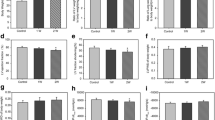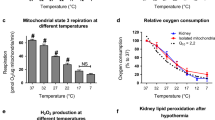Abstract
Cold injury is a tissue trauma produced by exposure to freezing temperatures and even brief exposure to a severely cold and windy environment. Rewarming of frozen tissue is associated with blood reperfusion and the simultaneous generation of free oxygen radicals. In this review is discussed the current understanding of the mechanism of action of free oxygen radicals as related to cold injury during rewarming. Decreased energy stores during ischaemia lead to the accumulation of adenine nucleotides and liberation of free fatty acids due to the breakdown of lipid membranes. On rewarming, free fatty acids are metabolized via cyclo-oxygenase and adenine nucleotides are metabolized via the xanthine oxidase pathway. These may be the source of free oxygen radicals. Leukocytes may also play a major role in the pathogenesis of cold injury. Oxygen radical scavengers, such as superoxide dismutase and catalase, may help to reduce the cold induced injury but their action is limited due to the inability readily to cross the plasma membrane. Lipid soluble antioxidants are likely to be more effective scavengers because of their presence in membranes where peroxidative reactions can be arrested.
Similar content being viewed by others
References
Beckman JS, Minor RL, White CW, Repine JE, Rosen GM, Freeman BA (1988) Superoxide dismutase and catalase conjugated to polyethylene glycol increases endothelial enzyme activity and oxidant resistance. J Biol Chem 263:6884–6892
Beckman JS, Beckman TW, Chen J, Marshall PA, Freeman PA (1990) Apparent hydroxyl radical production by peroxynitrite: implications for endothelial injury from nitric oxide and superoxide. Proc Natl Acad Sci USA 87:1620–1624
Bellman S, Adams-Ray J (1956) Vascular reaction after cold injury. Angiology 7:339–368
Bendich A, Machlin LJ, Scandurra O, Burton GW, Wayer DDM (1986) The antioxidant role of vitamin C. Adv Free Radical Biol Med 2:419–444
Boswick JA Jr, Thompson JD, Jonas RA (1979) The epidemiology of cold injuries. Surg Gynecol Obstet 149:326–332
Bourne MH, Piekkorn MW, Clayton F, Leonard LG (1986) Analysis of microvascular changes in frostbite injury. J Surg Res 40:25–35
Chen LH, Chang HM (1979) Effects of high level of vitamin C on tissue anti-oxidant status of guinea pigs. J Int Vitamin Nutr Res 49:87–91
Chow CL (1979) Nutritional influence on cellular anti-oxidant defense systems. Am J Clin Nutr 32:1066–1081
Cino M, Dalmaestro RF (1989) Generation of hydrogen peroxide by brain mitochondria: the effect of reoxygenation following post decapitative ischemia. Arch Biochem Biophys 269:623–638
Das DK, Iyengar J, Jones RM, Lu D, Maity S (1991a) Protection from non-freezing cold injury by quinacrine, a phospholipase inhibitor. Cryobiology 28:177–184
Das DK, Russel JC, Jones RM (1991b) Reduction of cold injury by superoxide dismutase and catalase. Free Radical Res Commun 12–13:653–662
Durand J, Martineua JP (1971) Resistance and capacitance vessels of the skin in permanent and temporary residents at high altitude. In: Porter R, Knight J (eds) High altitude physiology: cardiac and respiratory aspects. (Ciba Foundation Symposium). Churchill Livingstone, Edinburgh, p 159
Francis TJR (1984) Non-freezing cold injury: a historical review. J Roy Nav Med Serv 70:134–154
Gadarowki J Jr, Esce JD (1973) Acute systemic change in blood cells, protein coagulation, fibrinolysis and platelet aggregation after frost-bite injury in the rabbit. Cryobiology 10:9–21
Granger DN, Rutili G, McCord JM (1981) Superoxide radicals in feline intestinal ischemia. Gastroenterology 81:22–29
Granger DN, Hollwaroth ME, Parks DA (1986) Ischemiareperfusion injury: role of oxygen derived free radicals. Acta Physiol Scand Vol 126 [Suppl] 548:47–63
Hamberg M, Svensson J, Samuelsson B (1975) Thromboxanes: a new group of biologically active compounds derived from prostaglandin endoperoxides. Proc Natl Acad Sci USA 72:2994–2998
Harlan JM, Harken LA (1981) Homeostasis, thrombosis and thromboembolic disorders. The role of arachidonic acid metabolites in platelet-vessel wall interactions. Med Clin N Am 65:855–880
Hochachka PW, Dunn JF (1983) Metabolic arrest: the most effective means of protecting tissues against hypoxia. In: Sutton JR, Houston CS, Jones NL (eds) Hypoxia, exercise and altitude. Liss, New York, p 297
Hruba F, Novakova V, Ginter E (1982) The effect of chronic marginal vitamin C deficiency on the α-tocopherol content of the organs and plasma of guinea pigs. Experimentia 38:1454–1455
Iyengar J, George A, Russel JC, Das DK (1990) Generation of free radicals during cold injury and rewarming. Vascular Surgery 24:467–474
Jarasch Ed, Bruder G, Heid HW (1986) Significance of xanthine oxidase in capillary endothelial cells. Acta Physiol Scand 126 [Suppl] 548:39–46
Jennings RB, Reimer KA (1981) Lethal myocardial ischemic injury. Am J Pathol 102:241–251
Kettlecamp D, Walker M, Ramsey P (1971) Radioactive albumin, red blood cells and sodium as indicators of tissue damage after frost-bite. Cryobiology 8:79–83
Klausner RD, Kleinfeld AM, Hoover RL, Karnovsky MJ (1980) Lipid domains in membranes. Evidence derived from structural perturbation induced by fatty acid and lifetime heterogeneity analysis. J Biol Chem 255:1286–1296
Kulka JP (1965) Cold injury of the skin: the pathogenic role of microcirculatory impairment. Arch Environ Health 11:484–497
Manson PN, Jesudass R, Marzella L, Bulkley GB, Im MJ, Narayan KK (1991) Evidence for an early free radical mediated reperfusion injury in frostbite. Free Radical Res Commun 10:7–11
Matsubara T, Ziff M (1986) Superoxide anion release by human endothelial cells: synergism between a phorbol ester and a calcium ionophore. J Cell Physiol 127:207–210
McCord JM (1985) Oxygen derived free radicals in postischemic injury. N Engl J Med 312:159–163
Meryman HT (1957) Tissue freezing and local cold injury. Physiol Rev 37:233–250
Mileski WJ, Raymond JF, Winn RK, Harlan JM, Rice CL (1993) Inhibition of leucocyte adherence and aggregation for treatment of severe cold injury in rabbits. J Appl Physiol 74:1432–1436
Mills WJ, Wlfalay R, Fish W (1960) Frost-bite: experience with rapid rewarming and ultrasonic therapy. Alaska Med 2:114–118
Paton BC (1987) Pathophysiology of fristbite. In: Sutton JR, Houston CS, Coates G (eds) Hypoxia and cold. Praeger, New York, pp 329–339
Purkayastha SS, Mathew L (1992) Vitamin C in the prevention and treatment of frostbite. Defence Sci J 42:39–46
Purkayastha SS, Chhabra PC, Verma SS, Selvamurthy W (1993) Experimental studies on the treatment of frostbite in rats. Ind J Med Res (B) 98:178–184
Robson MC, Heggers JP (1981) Evaluation of hand frost bite blister fluid as a clue to pathogenesis. J Hand Surg 6:43–46
Rosen GM, Freeman BA (1984) Detection of superoxide generated by endothelial cells. Proc Natl Acad Sci USA 23:7263–7269
Roy RS, McCord JM (1983) Superoxide and ischemia: conversion of xanthine dehydrogenase to xanthine oxidase. In: Greenward R, Cohen G (eds) Oxyradicals and their scavenger systems. Elsevier, New York, pp 145–153
Russell JC, Lu D, Iyengar J, Das DK (1993) Reperfusion injury during frostbite and nonfreezing cold exposure. In: Das DK (ed) Pathophysiology of reperfusion injury. CRC Press, Boca Raton, pp 472–490
Seisjo BK (1981) Cell damage in the brain: a speculative synthesis. J Cereb Blood Flow Metab 1:155–185
Serhan CN, Brockman MJ, Korchak HM, Marcus AJ, Weissman G (1982) Endogenous phospholipid metabolism in stimulated neutrophils: differential activation by FMLP and PMA. Biochem Biophys Res Commun 107:951–958
Strock PE, Majno GM (1969) Microvascular changes in acutely ischemic rat muscle. Surg Gynecol Obstet 129:1213–1224
Tappel AL (1972) Vitamin E and free radical peroxidation of lipids. Ann New York Acad Sci 203:12–28
Traystman RJ, Kirsch JR, Kechler RC (1991) Oxygen radical mechanism of brain injury following ischemia and reperfusion. J Appl Physiol 71:1185–1195
Turrens JF, Crapo JD, Freeman BA (1984) Protection against oxygen toxicity by intravenous injection of liposome — entrapped catalase and superoxide dismutase. J Clin Invest 73:87–95
Weatherly — White RCA, Sjostrum B, Paton BC (1964) Experimental studies in cold injury. II. The Pathogenesis of frostbite. J Surg Res 4:17–22
Weiss SJ (1986) Oxygen, ischemia and inflammation. Acta Physiol Scand 126 [Suppl] 548:9–38
Yamamoto M, Shima T, Uozumi T, Sagabe T, Yamadada K, Kawasaki T (1983) A possible role of lipid peroxidation in cellular damage caused by cerebral ischemia and the protective effect of alpha-tocopherol administration. Stroke 14:977–982
Author information
Authors and Affiliations
Rights and permissions
About this article
Cite this article
Bhaumik, G., Srivastava, K.K., Selvamurthy, W. et al. The role of free radicals in cold injuries. Int J Biometeorol 38, 171–175 (1995). https://doi.org/10.1007/BF01245384
Received:
Revised:
Accepted:
Issue Date:
DOI: https://doi.org/10.1007/BF01245384




